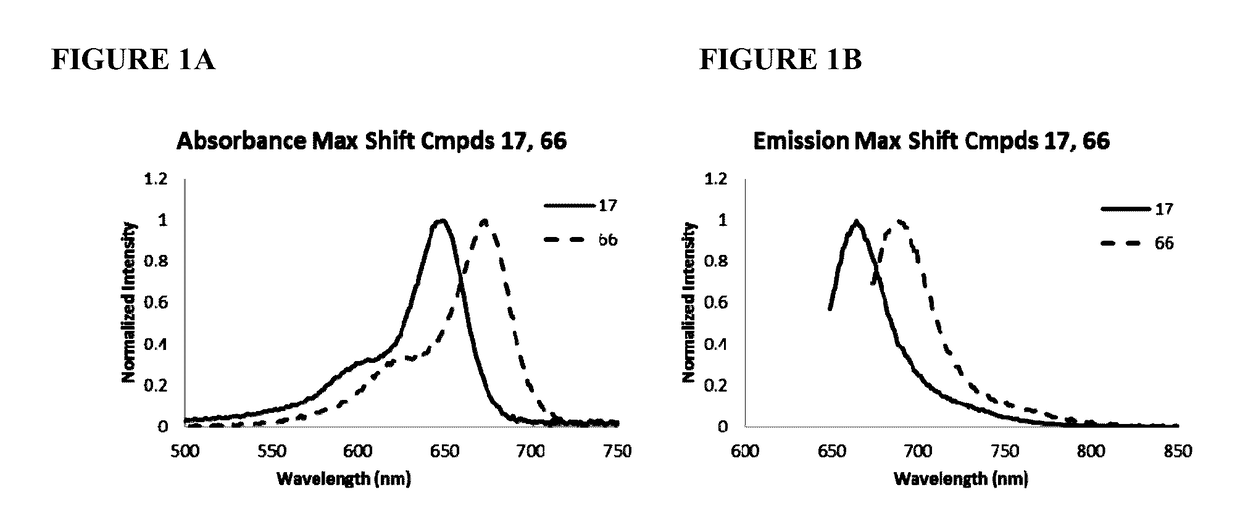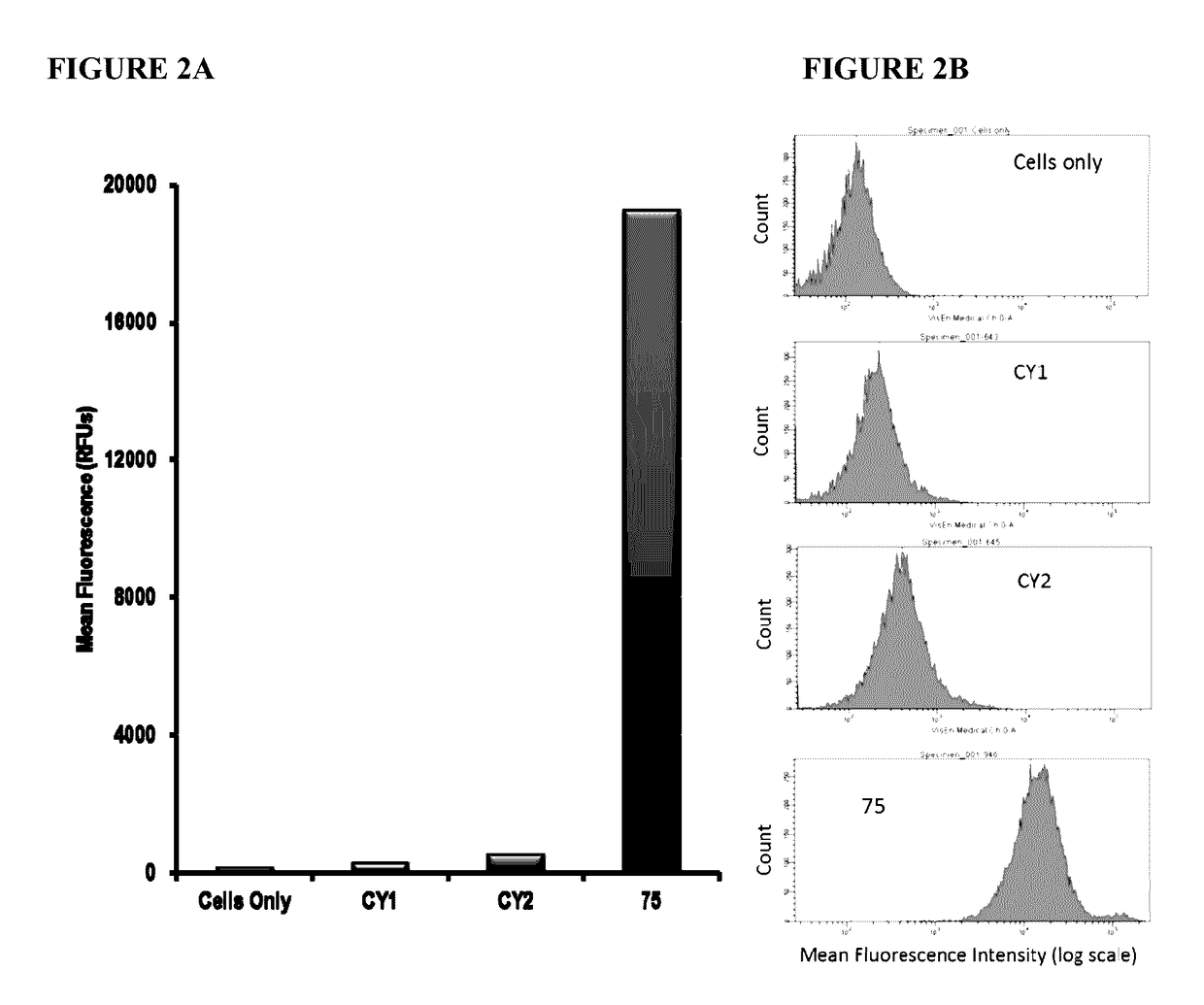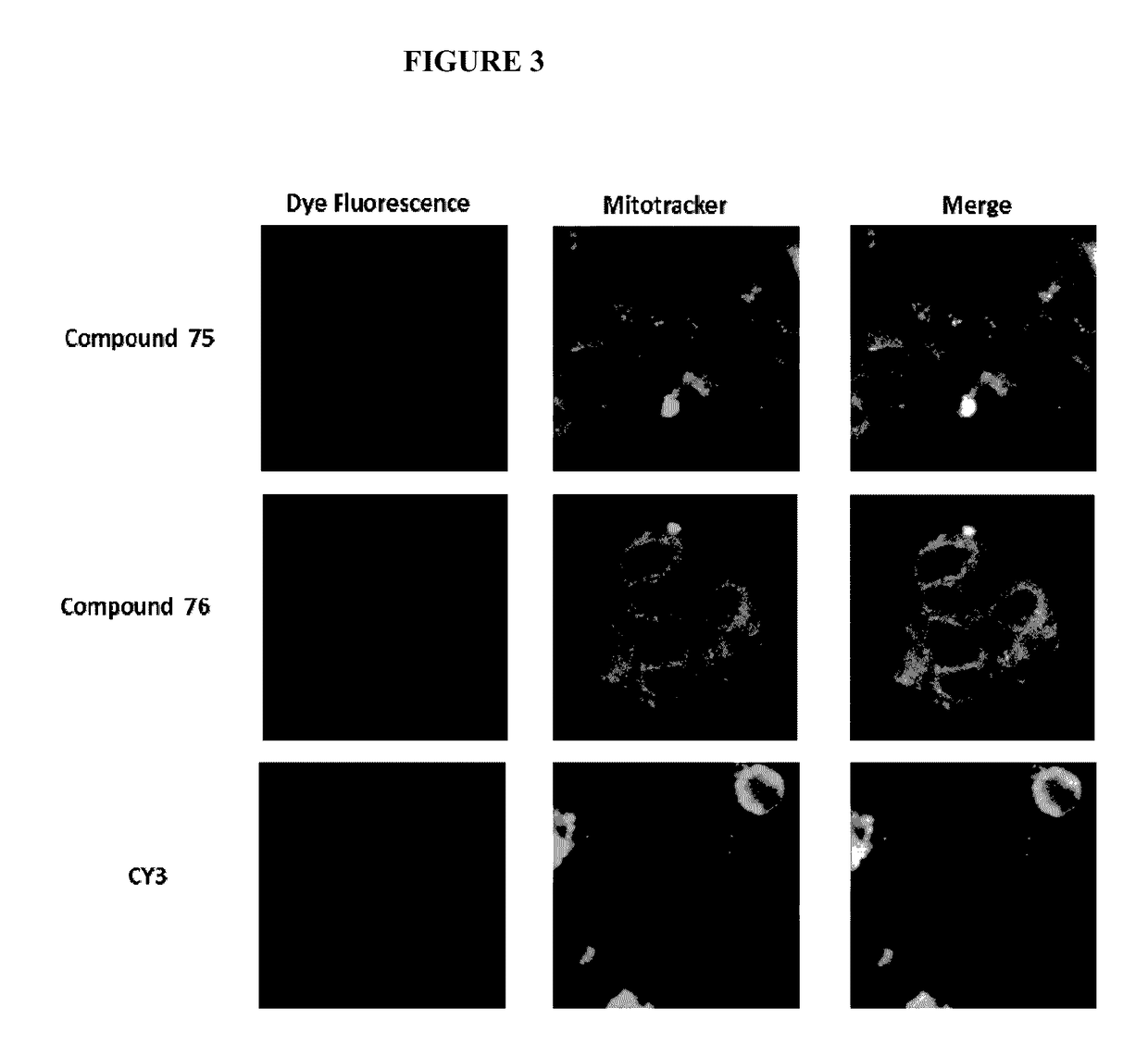Substituted silaxanthenium red to near-infrared fluorochromes for in vitro and in vivo imaging and detection
a fluorochrome and silaxanthenium red technology, applied in the field of fluorescent dyes (fluorochromes), can solve the problems of low cell membrane permeability, poor solubility in water, and limit the targeting of intracellular structures, and achieve significant cell permeability, optical properties, and low molecular weight
- Summary
- Abstract
- Description
- Claims
- Application Information
AI Technical Summary
Benefits of technology
Problems solved by technology
Method used
Image
Examples
example 1
of Compound 22: (3,6-bis(dimethylamino)-9-(2-carboxy-4-methyl-thien-5-yl)-10,10-dimethyl-10-silaxanthenium chloride)
Compound 22 was synthesized according to the following scheme:
[0223]
[0224]To a solution of compound N,N dimethyl-3-bromo aniline (10.0 g, 50.0 mmol) in AcOH (250 mL) was added 12.16 mL of 37% formaldehyde aqueous solution (4.5 g, 150.0 mmol), and the mixture was stirred at 60° C. for 115 min. After cooling to room temperature, a portion of acetic acid was removed by vacuum. Then, the reaction mixture was neutralized with saturated NaHCO3 aq. and NaOH aq., and extracted with CH2Cl2. The organic layer was washed with brine, dried over Na2SO4 and evaporated to dryness. The residue was purified by flash chromatography (silica gel) to give pure 4,4′-methylenebis(3-bromo-N,N-dimethylaniline) (5.24 g, 12.7 mmol, 51% yield).
[0225]
[0226]To a nitrogen purged flask, 4,4′-methylenebis(3-bromo-N,N-dimethylaniline) (1000 mg, 2.42 mmol) and anhydrous THF (25 mL) were added. The solut...
example 2
of Compound 65: (3,6-bis(dimethylamino)-9-(2-carboxy-thien-5-yl)-10,10-dimethyl-10-silaxanthenium chloride)
[0229]
[0230]To a nitrogen purged flask, 3,6-bis(dimethylamino)-10,10-dimethyl-10-silaxanthone (50.0 mg, 0.16 mmol) was dissolved in anhydrous THF (10 mL). The solution was cooled to −78° C. At the same temperature tert-butyl 4-bromo-3-methyl-2-thiophenecarboxylic acid (136 mg, 0.81 mmol) and anhydrous THF (5 mL) were added to a flask, 1 M s-BuLi (1.16 mL, 1.62 mmol) was added, and the mixture was stirred for 30 min. The lithiated solution was slowly added, and the mixture was warmed to r.t., then stirred for 2 h. The reaction was quenched by addition of 2 N HCl and the mixture was stirred at r.t. for 10 min. Saturated NaHCO3 was added, and the whole was extracted with CH2Cl2. The organic layer was dried over Na2SO4, and the solvent was evaporated. The crude mixture was purified by HPLC to afford pure 3,6-bis(dimethylamino)-9-(2-carboxy-thien-5-yl)-10,10-dimethyl-10-silaxantheni...
example 3
of Compound 18: (3,6-bis(dimethylamino)-9-(2-carboxy-3-methyl-thien-4-yl)-10,10-dimethyl-10-silaxanthenium chloride)
[0231]
[0232]To a nitrogen purged flask, 3,6-bis(dimethylamino)-10,10-dimethyl-10-silaxanthone (50.0 mg, 0.16 mmol) was dissolved in anhydrous THF (10 mL). The solution was cooled to −78° C. At the same temperature 3-methyl-4-bromo-2-thiophenecarboxylic acid (136 mg, 0.81 mmol) and anhydrous THF (5 mL) were added to a flask, 1 M s-BuLi (1.16 mL, 1.62 mmol) was added, and the mixture was stirred for 30 min. The lithiated solution was slowly added, and the mixture was warmed to r.t., then stirred for 2 h. The reaction was quenched by addition of 2 N HCl and the mixture was stirred at r.t. for 10 min. Saturated NaHCO3 was added, and the whole was extracted with CH2Cl2. The organic layer was dried over Na2SO4, and the solvent was evaporated. The crude mixture was purified by HPLC to afford pure 3,6-bis(dimethylamino)-9-(2-carboxy-3-methyl-thien-4-yl)-10,10-dimethyl-10-silax...
PUM
| Property | Measurement | Unit |
|---|---|---|
| absorption and emission wavelength | aaaaa | aaaaa |
| absorption and emission wavelength | aaaaa | aaaaa |
| wavelengths | aaaaa | aaaaa |
Abstract
Description
Claims
Application Information
 Login to View More
Login to View More - R&D
- Intellectual Property
- Life Sciences
- Materials
- Tech Scout
- Unparalleled Data Quality
- Higher Quality Content
- 60% Fewer Hallucinations
Browse by: Latest US Patents, China's latest patents, Technical Efficacy Thesaurus, Application Domain, Technology Topic, Popular Technical Reports.
© 2025 PatSnap. All rights reserved.Legal|Privacy policy|Modern Slavery Act Transparency Statement|Sitemap|About US| Contact US: help@patsnap.com



